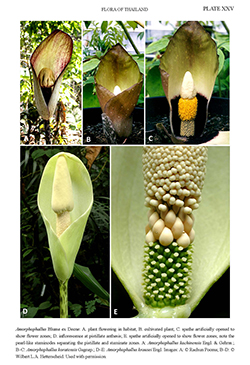e-Flora of Thailand
Volume 11 > Part 2 > Year 2012 > Page 155 > Araceae > Amorphophallus
24. Amorphophallus kachinensis Engl. & Gehrm.
n Engl., Pflanzenr. IV, 23C (Heft 48): 9. 1911; Li & Hetterschied in H.Li et al., Fl. China 23: 28–29. 2010. Plate XXV: A.
Accepted Name : This is currently accepted.
Synonyms & Citations :
Description : Tuber depressed-globose, 5–30 by 3–25 cm, developing rhizomatous offsets ca 5 by 1 cm. Leaf solitary; petiole 20–120 cm long, smooth, dirty white with dark green to reddish brown spots; leaf blade 30–100 cm diam.; leaflets elongate-elliptic, 6–15 by 2–6 cm, acute-acuminate. Inflorescence solitary, long pedunculate; cataphylls 9–20 cm long; peduncle 24–80 cm by 7–10 mm, ivory-white, greyish or greenish with brown or purple blotches and greenish patches; spathe 8–31 by 7–14 cm, concave, base shortly convolute, exterior green, pale green or greenish brown with green or olive-green spots or purplish red stripes and spots, apex purple, interior pale green in a broad zone along the midrib, then maroon to the margin with narrow, irregularly pale green zones around the main veins; base within bearing scattered, low, punctiform warts; spadix much shorter than spathe, 6.5–18 cm long, stipitate; stipe 2–10 by 4–10 mm; pistillate flower zone slightly obconical or cylindrical, 1.3–5 cm by 6–14 mm, flowers congested, the lower ones often more loosely arranged; ovaries globose or subpyriform, 1.5 cm by ca 2 mm, after anthesis (fertilisation?) articulated to the style, dark purple; style more or less strongly upcurved, slender, dark purple, 1–2 mm long; stigma thin, subglobose or flattened, 0.4 by 0.7–1 ca mm, triradiate or entire, apical or subapical, often transversely expanded beyond the style and sub-bilabiate, surface verrucate, verrucae sometimes elongate and protruding; staminate flower zone obconical, occasionally fusiform, 2–4 by 1.2–3 cm, base often constricted, flowers congested; staminate flowers 3–6-androus; stamens white; appendix stipitate, occasionally sessile, ovate or conical, occasionally nearly globose, 5.5–7 by 2–4 cm, apex truncate, rounded or rarely acute, dirty white, surface often with a few deep, longitudinal grooves or with a few shallow folds, smooth, base constricted and lobed; stipe 3–15 by 8–20 mm. Fruit elongate, ripening orange.
Thailand : NORTHERN: Chiang Mai, Chiang Rai, Nan.
Distribution : China (Yunnan – type of Amorphophallus bannaensis), N Myanmar (type), Laos.
Ecology : Dense primary forests on limestone; 1,000–1,600 m alt.
Vernacular : Buk kap khong (บุกกาบโค้ง)(Northern).
Notes: Amorphophallus kachinensis is morphologically very close to A. corrugatusbut differs in the much less complexly fissured appendix and the pores of the anthers, the position of which varies from subapical to sublateral, depending on the dimensions of the connective. From A. yunnanensis it differs in the longer style, smaller stigma, the position of the pores and the colour pattern in several parts of its morphology.

